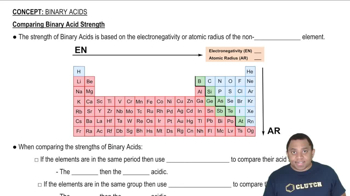Ch.22 - The Main Group Elements
Chapter 22, Problem 10
Consider the following oxoacids: HClO, HClO2, HClO3, and HClO4. In which oxoacid does chlorine have an oxidation state of +5? Which oxoacid is the strongest?
(LO 22.17)
(a) HClO has a Cl oxidation state of +5, and HClO4 is the strongest acid.
(b) HClO2 has a Cl oxidation state of +5, and HClO is the strongest acid.
(c) HClO3 has a Cl oxidation state of +5, and HClO4 is the strongest acid.
(d) HClO4 has a Cl oxidation state of +5, and HClO is the strongest acid.
 Verified step by step guidance
Verified step by step guidance1
Step 1: Determine the oxidation state of chlorine in each oxoacid. Use the formula: Oxidation state of Cl = (Total charge of the compound) - (Sum of oxidation states of other elements).
Step 2: For HClO, assign oxidation states: H is +1, O is -2. Solve for Cl: +1 + Cl - 2 = 0.
Step 3: For HClO2, assign oxidation states: H is +1, each O is -2. Solve for Cl: +1 + Cl + 2(-2) = 0.
Step 4: For HClO3, assign oxidation states: H is +1, each O is -2. Solve for Cl: +1 + Cl + 3(-2) = 0.
Step 5: For HClO4, assign oxidation states: H is +1, each O is -2. Solve for Cl: +1 + Cl + 4(-2) = 0.

Verified video answer for a similar problem:
This video solution was recommended by our tutors as helpful for the problem above.
Was this helpful?
Key Concepts
Here are the essential concepts you must grasp in order to answer the question correctly.
Oxidation State
The oxidation state of an element in a compound indicates the degree of oxidation or reduction of that element. It is a theoretical charge that an atom would have if all bonds were ionic. In oxoacids, the oxidation state of the central atom (like chlorine in HClO, HClO2, HClO3, and HClO4) can be determined by considering the number of oxygen atoms and the overall charge of the molecule.
Recommended video:
Guided course

Oxidation Numbers
Oxoacids Strength
The strength of oxoacids is influenced by the number of oxygen atoms bonded to the central atom. Generally, as the number of oxygen atoms increases, the acid strength increases due to greater resonance stabilization of the conjugate base. In this case, HClO4, with four oxygen atoms, is the strongest acid among the given oxoacids.
Recommended video:
Guided course

Comparing Binary Acid Strength
Resonance Structures
Resonance structures are different ways of drawing the same molecule that illustrate the delocalization of electrons. In oxoacids, resonance can stabilize the conjugate base formed after deprotonation. The more resonance structures available, the more stable the conjugate base, which typically correlates with stronger acid behavior, as seen in HClO4 compared to the other oxoacids.
Recommended video:
Guided course

Resonance Structures
Related Practice
